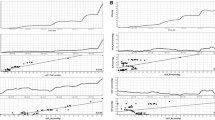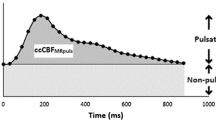Abstract
Cerebral hemodynamic changes in infants with progressive hydrocephalus have been studied with the transcranial Doppler (TCD) technique. Several authors have referred to the correlation between the hemodynamic changes and increased intracranial pressure (ICP). Despite conflicting conclusions on the value of pulsatility index (PI) measurements for monitoring infantile hydrocephalus, these pulsatility indices are the most commonly used for this purpose. Although clinical signs of raised ICP are highly variable and unreliable in infants, assumptions have been made in most of the studies about the presence of elevated ICP on the basis of the patient's clinical state. Few studies have reported on actual ICP values, however, and a direct relationship between ICP and TCD changes has never been adequately demonstrated. In the present study, this relationship was investigated in long-term simultaneous TCD/ICP measurements, in an attempt to develop a noninvasive method of monitoring the effect of ICP on intracranial hemodynamics. Two groups of data sets were established. Group I consisted of pre- and postoperative (shunt implantation) TCD/ICP measurements. Group II were long-term simultaneous TCD/ICP recordings showing significant ICP variations. In most of the postoperative measurements there was a decrease in the average PI and RI values. The correlation between PI or RI and ICP in the long-term simultaneous recordings, however, was generally poor. The risk of obtaining false positive or false negative PI or RI values in short-term measurements was also demonstrated. It can be concluded from our results, besides the wide range of reference values for the Doppler indices and extracranial influences upon them, that the present Doppler indices are inadequate for monitoring the complex intracranial dynamic responses in patients with raised ICP.
Similar content being viewed by others
References
Aaslid R, Markwalder TM, Nornes H (1982) Noninvasive transcranial Doppler ultrasound recording of flow velocity in the basal cerebral arteries. J Neurosurg 57:769–774
Alvisi C, Marziano C, Giulioni M, Monari P, Salvioli GP (1985) Evaluation of cerebral blood flow changes by transfontanelle Doppler ultrasound in infantile hydrocephalus. Child's Nerv Syst 1:244–247
Anderson JC, Mawk JR (1988) Intracranial arterial duplex Doppler waveform analysis in infants. Child's Nerv Syst 4:144–148
Beintema DJ, Prechtl H (1968) A neurological study of newborn infants: state of the infant. Clin Dev Med 28:28–41
Bel F van, Bor M van de, Baan J, Stijnen T, Ruys JH (1988) Blood flow velocity pattern of the anterior cerebral arteries before and after drainage of posthemorrhagic hydrocephalus in the newborn. J Ultrasound Med 7:553–559
Bode H, Wais U (1988) Age dependence of flow velocities in basal cerebral arteries. Arch Dis Child 63:606–611
Brouwers PJAM, Vriens EM, Musbach M, Wieneke GH, Huffelen AC van (1990) Transcranial pulsed Doppler measurements of blood flow velocity in the middle cerebral artery: reference values at rest and during hyperventilation in healthy children and adolescents in relation to age and sex. Ultrasound Med Biol 16:1–8
Chadduck WM, Seibert JJ (1989) Intracranial duplex Doppler: practical uses in paediatric neurology and neurosurgery. J Child Neurol 4:77–86
Chadduck WM, Crabtree HM, Blankenship JB, Adametz JR (1991) Transcranial Doppler ultrasonography for the avaluation of shunt malfunction in pediatric patients. Child's Nerv Syst 7:27–30
Deeg KH, Paul J, Rupprecht T, Harms D, Mang C (1988) Pulsed Doppler sonographic determination of absolute flow velocities in the anterior cerebral artery in infants with hydrocephalus, in comparison with a healthy patient sample. Monatsschr Kinderheilkd 136:85–94
Drayton MR, Skidmore R (1986) Doppler ultrasound in the neonate. Ultrasound Med Biol 12:761–772
Efron B, Tibshirani RJ (1993) An introduction to the bootstrap. Chapman & Hall, New York
Evans DH (1992) Doppler ultrasound and the neonatal cerebral circulation: methodology and pitfalls. Biol Neonate 62:271–279
Finn JP, Quinn MW, Hall-Craggs MA, Kendall BE (1990) Impact of vessel distortion on transcranial Doppler velocity measurements: correlation with magenetic resonance imaging. J Neurosurg 73:572–575
Fischer AQ, Livingston JN (1989) Transcranial Doppler and realtime cranial sonography in neonatal hydrocephalus. J Child Neurol 4:64–69
Goh D, Minns RA, Pye SD, Steers AJW (1991) Cerebral blood flow velocity changes after ventricular taps and ventriculoperitoneal shunting. Child's Nerv Syst 7:452–457
Goh D, Minns RA, Pye SD (1991) Transcranial Doppler (TCD) ultrasound as a noninvasive means of monitoring cerebrohaemodynamic change in hydrocephalus. Eur J Pediatr Surg 1 [Suppl 1]:14–17
Goh D, Minns RA, Hendry GMA, Thambyayah M, Steers AJW (1992) Cerebrovascular resistive index assessed by duplex Doppler sonography and its relation to intracranial pressure in infantile hydrocephalus. Pediatr Radiol 22:246–250
Goh D, Minns RA, Pye SD, Steers AJW (1992) Cerebral blood flow velocity and intermittent intracranial pressure elevation during sleep in hydrocephalic children. Dev Med Child Neurol 34:676–689
Gosling H, King DH (1974) Continuous wave ultrasound as an alternative and complement to X-ray in vascular examinations. In: Reneman RS (ed) Cardiovascular application of ultrasound. Elsevier, New York, pp 266–282
Grant EG, White EM, Schellinger D, Choyke PL, Sarcone AL (1987) Cranial duplex sonography of the infant. Radiology 163:177–185
Heistad DD, Marcus AL, Abboud FM (1978) Role of large arteries in regulation of cerebral blood flow in dogs. J Clin Invest 62:761–768
Hill A, Volpe JJ (1982) Decrease in pulsatile flow in the anterior cerebral arteries in infantile hydrocephalus. Pediatrics 69:4–7
Horikawa M (1991) Usefulness of Doppler method for evaluating intracranial hemodynamics in infantile hydrocephalus. No To Hattatsu 23:200–206
Huang CC, Chio CC (1991) Duplex color ultrasound study of infantile progressive hydrocephalus. Child's Nerv Syst 7:251–256
Jong DA de, Maas AIR, Ouden AH den, Lange SA de (1984) Non-invasive intracranial pressure monitoring. A technique for reproducible fontanelle pressure measurements. Z Kinderchir 39:274–276
Kato Y, Auer LM (1989) Cerebrovascular response to elevation of ventricular pressure. Acta Neurochir 98:184–188
Kirkpatrick M, Engelman H, Minns RA (1989) Signs and symptoms of progressive hydrocephalus. Arch Dis Child 64:124–128
Kontos HA, Wei EP, Navari RM, Levasseur JE, Rosenblum WI, Patterson JL (1978) Responses of cerebral arteries and arterioles to acute hypotension and hypertension. Am J Phys 234:H371-H373
Levin SD, Brown JK, Harkness RA (1984) Cerebrospinal fluid hypoxanthine and xanthine concentrations as indicators of metabolic damage due to raised intracranial pressure in hydrocephalic children. J Neurol Neurosurg Psychiatry 47:730–733
Lui K, Hellmann J, Sprigg A, Daneman A (1990) Cerebral blood flow velocity patterns in posthemorrhagic ventricular dilatation. Child's Nerv Syst 6:250–253
Minns RA, Goh D, Pye SD, Steers AJW (1991) A volume-blood flow velocity response (VFR) relationship derived from CSF compartment challenge as an index of progression of infantile hydrocephalus. In: Matsumoto S, Tamali N (eds) Hydrocephalus: pathogenesis and treatment. Springer, Tokyo Berlin Heidelberg, pp 270–278
Nishimaki S, Kawakami T, Akamatsu H, Iwasaki Y (1991) Cerebral blood flow velocities in the anterior cerebral arteries and basilar artery. Investigation in hydrocephalus (part 2). No To Hattatsu 23:560–566
Norelle A, Fischer AQ, Flannery AM (1989) Transcranial Doppler: a noninvasive method to monitor hydrocephalus. J Child Neurol 4:87–90
Overweg-Plandsoen WCG (1990) The Rotterdam Teletransducer. Anterior fontanelle pressure monitoring in infants. Thesis, Rotterdam, pp 28–37
Pople IK (1992) Doppler flow velocities in children with controlled hydrocephalus: reference values for the diagnosis of blocked cerebrospinal fluid shunts. Child's Nerv Syst 8:124–125
Pople IK, Quinn MW, Bayston R, Hayward RD (1991) The Doppler pulsatility index as a screening test for blocked ventriculoperitoneal shunts. Eur J Pediatr Surg 1 [Suppl 1]:4
Pourcelot L (1974) Applications cliniques de l'examen Doppler transcutane. In: Peroneau P (ed) Vélocimètre ultrasonore Doppler. (INSERM, vol 34) INSERM, Paris, pp 213–240
Quinn MW (1989) Intracranial arterial duplex Doppler waveform analysis in infants. Child's Nerv Syst 5:54–58
Rosner MJ, Becker DP (1984) Origin and evolution of plateau waves. J Neurosurg 60:312–324
Sanker P, Richard KE, Weigl HC, Klug N, Leyen K van (1991) Transcranial Doppler sonography and intracranial pressure monitoring in children and juveniles with acute brain injuries or hydrocephalus. Child's Nerv Syst 7:391–393
Sayawa R, Ingvar DH (1989) Cerebral blood flow and metabolism in sleep. Acta Neurol Scand 80:481–491
Seibert JJ, McCowan TC, Chadduck WM, Adametz JR, Glasier CM (1989) Duplex pulsed Doppler US versus intracranial pressure in the neonate: clinical and experimental studies. Radiology 171:155–159
Tranquart F, Bray JM de, Berson M, Akoka S, Bodard S, Pourcelot L (1994) Concurrent changes in intracranial pressure, cerebral blood flow velocity, and brain energy metabolism in rabbits with acute intracranial hypertension. Child's Nerv Syst 10:285–292
Wozniak M, McLone DG, Raimondi AJ (1975) Micro- and macrovascular changes as the direct cause of parenchymal destruction in congenital murine hydrocephalus. J Neurosurg 43:535–545
Author information
Authors and Affiliations
Rights and permissions
About this article
Cite this article
Hanlo, P.W., Gooskens, R.H.J.M., Nijhuis, I.J.M. et al. Value of transcranial Doppler indices in predicting raised ICP in infantile hydrocephalus. Child's Nerv Syst 11, 595–603 (1995). https://doi.org/10.1007/BF00300999
Received:
Issue Date:
DOI: https://doi.org/10.1007/BF00300999




